 |
 |
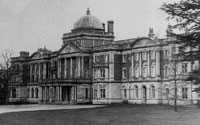 |
Elveden Hall 3rd Bombardment Division and 3rd Air Division Headquarters Elveden Hall became the home of the 3rd Bombardment Division in September 1943. As the Head quarters for the Division it had no airfield, but soon acquired temporary huts and installations necessary for a large Headquarters staff. | ||||||
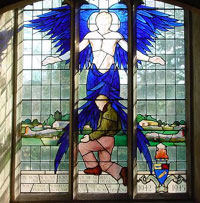 |
When the USAFE was undertaking the build up necessary for the invasion of Europe, it was felt necessary to improve the organisation in order to cope with greater numbers of personnel and equipment, and to bring the bombers and their fighters together under one command. So in January of 1945, Elveden was again enlarged to house the Headquarters of the new 3rd Air Division. In August 1945, the Headquarters was shut down, and Elveden was abandoned. It was not lived in again until the end of the century. A memorial window to the men of the Third Air Division who died during the War was created for the Church.
Contact:- | ||||||
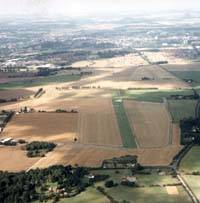 |
Rougham Airfield and the 94th Bomb Group
The story of Rougham Airfield, later officially called Bury St Edmunds, but still known locally as Rougham began a year before the 94th Bomb Group arrived.
The airfield was built by Costain's and opened in August 1942. For six weeks in August and September 1942 the 47th Bomb Group flew 8 A20 Bostons from Rougham. The base was empty until December 1942 when the ground crew for the 322nd Bomb Group arrived. In March 1943 their Marauder bombers arrived but they moved on to Andrews Field on 13th June 1943. | ||||||
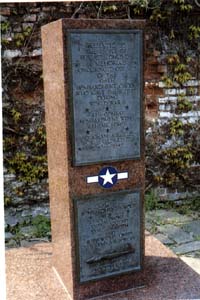
|
With the arrival of the 94th the field was extended to 50 hardstandings and dispersal areas, 3 of which were diamond shaped to give capacity for 50 aircraft. The main runway was east to west and was 2,000 yards long and 50 yards wide. A second runway was 1,400 yards from north to south, and the third was also 1,400 yards north to south east. The most important buildings were the Operations Room and the Control Tower which is currently under restoration by the Rougham Tower Association. In late 1944 the 94th Bomb Group at Rougham held a 200th Mission Party that year, with the AAF band, usually led by Glenn Miller, putting on a great show. Leroy Kuest remembered: “Glenn Miller’s band showed up with singer Dinah Shore.” The great man wasn’t there, but Ray McKinley led the musicians and the audience was swollen by land army girls, civilians and other folk, dancing on the concrete floor of the main hangar. “We had a wonderful time.”
During their stay at Rougham the 94th Bomb Group carried out 325 missions, were credited with 8,824 sorties and dropped 18,925 tons of bombs. This was at a cost of 153 aircraft missing with 27 lost through operational accidents. With a crew of 10 per aircraft the human cost was approximately 1,800 persons killed, missing, injured or captured. The B17 Flying Fortress bomber flown by the 94th is recalled in the name of a public house and restaurant of the same name (The Flying Fortress), which now stands on part of the airfield site. The 94th Bomb Group Memorial Association has a partnership with St Edmundsbury Borough Council for the maintenance and upkeep of parts of the Appleby Memorial Rose Garden in the Abbey Gardens in Bury St Edmunds. The Council maintains the memorials in the Rose Garden using funds provided by the Association. The Memorial Association has now been wound up and is succeeded by the 94th Bomb Group Auxiliary Association
Contact:-
Rougham Airfield is brought "back to life" by the Rougham Tower Association (RTA).
The Rougham Tower Association which is a registered charity was formed with the aim of restoring the former Control Tower and its surroundings for the benefit of education and to provide an enduring memorial to all those who served there during World War II.
Contact:-
The 388th flew B17 Flying Fortresses out of Knettishall for 2 years as part of the 3rd Air Division from 23rd June 1943 to 5th August 1945. It flew 306 missions and 25 experimental missions, at a cost of 142 B17's lost in action.
In September 1943, the 388th Bomb Group was transferred into the 45th Combat Bomb Wing, along with 96th Bomb Group (Snetterton) and 452nd Bomb Group (Deopham Green).
The old entrance to this airfield now has a handsome black granite memorial to the 388th. It stands at Coney Weston Crossroads and displays the "Fortress for Freedom" motto. This Association is very active and in 1992 set up a small museum in a war-time Nissen hut. The hut was moved to Hillside Farm, Market Weston, where it is now open to the public on the first and last Sundays of the month.
The 388th Group's current UK connection is:
David A Calcutt, Langmere, Church Road, Barningham
|
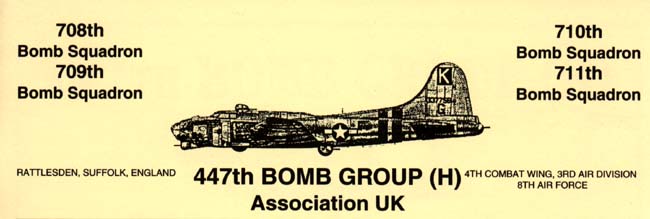
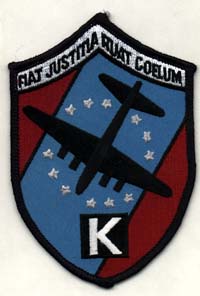 |
From December 1942 to April 1943 the 322nd Bomb Group (M) flew the medium bomber B-26 Marauder from Rattlesden, until all the Marauder groups were moved to Essex to improve their range over the continent. In November 1943 the 447th flew its B17's from the USA to Rougham, and on to Rattlesden next day. Staff Sargeant Eddie Leighty flew 30 missions with the 447th and in one mission returned with only one of the four engines working. He married a local girl and settled in the village. Planes of the 447th included "The Milk Waggon" and "Fuddy Duddy" and the photographs here are from the collection of Ernest Osborne as are some of the illustrations about the 8th Army Air Force. The 447th flew 257 missions and lost 153 aircraft in action, before flying back to the USA in June 1945. |
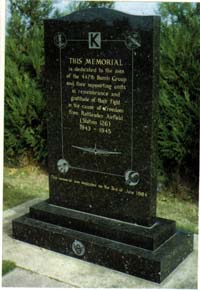 |
The 447th BG Association was formed in 1982, with a view to raising sufficient funds to erect a Memorial to the 447th Bomb Group. Additional members were collected along the way, and two years and £2,000 later, the Memorial was dedicated. An additional £2,000 was then raised to place in a Trust Fund for the future upkeep of the Memorial and following several years of negotiation, an agreement was reached with the American Battle Monuments Commission whereby they would take over the upkeep of the Memorial Site when the Association could no longer do so themselves. On legal advice, the Association applied for charitable status, which was achieved in 1991, and its Charity Registration is 100537. The Association continues to maintain a written and photographic record of the 447th Bomb Group's time at Rattlesden, and regularly stages Exhibitions for local organisations.
Fundraising events are held occasionally, in the name of the 447th Bomb Group, on behalf of local charities, and assistance is provided wherever required, be it with information requested by the many letters and telephone enquiries received, or with guided assistance for visitors to the airfield. |
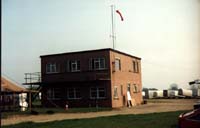 |
Rattlesden airfield is still used in part for flying on a club basis, although this is mostly a glider operation. Rattlesden Gliding Club now owns the runway and the refurbished control tower and twenty nine veterans of the 447th contributed funds to help bring this about. The 447th Memorial is located along the old East-West runway at Hightown Green. The 1997 reunion of the American Veterans of the 447th Bomb Group was a great success. Sixty people came over for this event, making it one of the biggest reunions of recent years. A further reunion is planned in 1999, hopefully in Bury St Edmunds rather than based in Cambridge. |
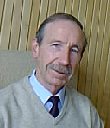 |
The Association's UK Liaison Officer is:
Ernest Osborne, 3 Oliver Road, Bury St Edmunds |
 |
Sudbury and the 486th Bomb Group Association
Sudbury airfield was opened in 1944 and for 12 months was an active American wartime base, although local boys called it Acton Aerodrome.
The 486th BG arrived from the USA in April 1944 flying B-24 Liberators, and 46 missions were flown in the B24. In July 1944 the Group converted to the B-17G Flying Fortresses and flew another 142 missions. Overall, thirty three B24's and B17's were lost in action. |
 |
The original tail markings of the 486th was an O in a square when they flew Liberators. This was changed to a W in a square with the arrival of the Flying Fortresses. Off duty there were monthly dances in the base Aero Club which was located off Folly Road, Great Waldingfield. The American Red Cross Service Club stood in East Street, Sudbury. When the 486th Group left Sudbury in August 1945, they presented a bronze tablet to the citizens of the town for their fellowship, understanding and hospitality which can still be seen on the Town Hall. The Association provided a handsome memorial stone outside St Gregory's Church in Sudbury in 1987, which illustrates both types of heavy bomber flown from the Base. The current UK contact for the 486th Bomb Group Association is:- "Yet to be confirmed". |
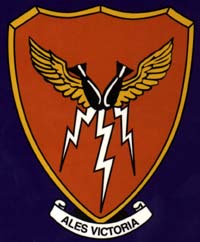 |
Great Ashfield and the 385th Bomb Group
Great Ashfield opened in March 1943 and became the base for the 385th Bomb Group in June 1943 until August 1945. The Group's first Commander was Colonel Van Devanter and the Group were known as "Van's Valiants". They flew 296 missions with the loss of 129 Flying Fortresses. One B17 was lost to a Junkers 88 bomb raid on the base. The 385th received two Distinguished unit Citations (DUC), the first for Regensburg and in October 1943 for leading the attack on the Marienburg FW190 factory.
The 385th were part of the 4th Combat Bomb Wing along with the 94th at Rougham (HQ 4th CBW) and the 447th at Rattlesden. Later the 486th at Sudbury and the 487th at Lavenham were to join the 4th Wing.
A local Red Cross Worker, Annie Hayward, painted the nose-art of many of the Ashfield B17's, as well as the backs of individual flying jackets. One B17 was named in her honour "Haybag Annie".
Great Ashfield tower call sign was Hardlife and Hardlife Herald became the name of the newsletter issued by the stateside 385th Memorial Association.
The Perle, Luxembourg 'Friends of the 385th Bomb Group' have a 385th Bomb Group Memorial Site. In memorial to the B-17 crewmen who crashed near the village of Perle in July 1944.
|
| Debden, Essex and the 4th Fighter Group
Debden was an RAF station from 1935 and flew Hurricanes and Blenheims in the 1940 Battle of Britain, when it was also bombed by the Luftwaffe. Castle Camps was opened as a satellite station in July 1940. In 1941 157 Mosquito
Squadron was formed at Debden and equipped at Castle Camps.
Debden was then home to the top-scoring "Eagles" of the American 4th Fighter Group from September 1942 to July 1945.
The Eagles flew 36 Spitfires until April 1943, then P47 Thunderbolts until February 1944, when they converted to P51 Mustangs. In October 1944 616 Squadron arrived with its new Meteor jet fighters to develop tactics.
After the war in July 1945 the station reverted to the RAF, and the 4th had to move to Steeple Morden, to return to the USA in November 1945. RAF technical training continued until 1960 when it became RAF Police Depot until 1975. Later Debden was taken over by the Army as home to the 9th/12th Royal Lancers.
At least four books have been written about life at Debden, reflecting its importance in the history of the Eighth Air Force. | |
|
Honington and the First Strategic Air Depot and 364th Fighter Group
Honington was built as a permanent RAF station and housed transport and bomber squadrons for its first five years. The USAAF took it over in 1942 and used it as a depot for major aircraft overhauls, later specialising in the B17 Flying Fortresses. Some badly damaged B17's would be re-routed straight to Honington on return from action, instead of landing at their home bases.
Along with the First SAD, Honington was home to the 364th Fighter Group. From February 1944 to July 1944 the 364th flew the P38 Lightning, and then were converted to Mustangs.
In March 1946 RAF Transport Command moved in and the base was crucial to the Berlin Airlift of 1948-49. Honington has since seen Canberras, the Valiant V-Bomber, Buccaneers, Shackletons and Tornadoes.
RAF Honington is now home to the RAF Regiment. | |
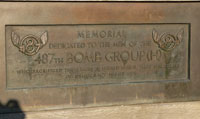 |
Lavenham Airfield and
487th Bomb Group
Lavenham Airfield was developed around Lodge Farm in 1943. The 487th aircrew arrived in April 1944 flying B24 Liberator bombers. Its first Commanding Officer was Colonel Beirne Lay who had been a Hollywood script-writer. Although he was shot down in May 1944 one of his scripts was to become the film "Twelve O'Clock High". The 487th flew 46 missions in Liberators until July 1944 when the group converted to the B17 Flying Fortresses.
Although the 4th Combat Bomb Wing had its HQ at Rougham, its commander, Colonel, then Brigadier-General Frederick W Castle, lost his life flying out of Lavenham with the 487th. On December 24th 1944 he commanded the 487th and led the air task force in the biggest 8th Air Force action of the war involving over 2,000 heavy bombers. Following engine trouble, his lagging B17 was shot down by enemy fighters. His portrait hangs in the Swan Hotel at Lavenham, and another in the Mayors' Parlour of St Edmundsbury Borough Council in Angel Corner, Bury St Edmunds.
The 487th left Lavenham in October 1945 after a total of 185 missions and 48 planes lost.
The 487th Group's current UK contact is: |
| Ridgewell, Essex and the 381st Bomb Group
Ridgewell was built as a satellite for Stradishall and on December 30th 1942 the newly formed 90 Squadron (RAF) flew in Stirling bombers from Bottesford.
The RAF used the Stirlings for minelaying and bombing of targets such as Hamburg, Essen and Duisburg but in May 1943, 90 Squadron moved to West Wickham.
The 381st Bomb Group arrived at Ridgewell in June 1943 in its B17 Flying Fortresses.
The 381st was part of the First Air Division and received two Distinguished Unit Citations. It had two planes which successfully completed over 100 missions, "Rotherhithe's Revenge" and "Stage Door Canteen". The tail fins of 381st planes carried an L within a triangle, the triangle denoting the 1st Air Division which was mainly located in Cambridgeshire and Northamptonshire.
297 missions were flown up to 25th April 1945 and 131 B17's were lost in action. The 381st returned to the USA in June 1945, leaving Ridgewell to RAF Maintenance Command. Number 94 MU was here from September 1946 to March 1957, and now it is largely farmland.
The 381st Group's current UK connection is:
The 381st have their own website at www.381st.org
| |
| Little Walden, Essex
Little Walden or Hadstock was built between Linton and Saffron Walden in 1943 and opened in March 1944 assigned to the US 9th Air Force.
The 409th Light Bomb Group arrived flying A20 Havocs. Together with Wethersfield and Gosfield they made up the 97th Combat Wing, attacking tactical targets as part of the D Day build up.
In May 1944 a local woman was killed near Ashdon trying to help the crew in a crashed Havoc which exploded.
After June 6th D Day, the 409th and other units of 9th AF moved to the continent.
In the first three months of 1945 the 361st FG was in France but returned in April and Little Walden reverted to being a fighter base. The 56th FG (The Wolfpack) also arrived in the summer and both units returned to the USA in November 1945.
The base closed in January 1946.
| |
| Friends of the Eighth (FOTE)
FOTE is an informal organisation, formed in 1972, by a nucleus of individuals interested in preserving the history of the United States 8th Air Force.
From the interest generated, friendships have developed over the intervening years between the various 8th Air Force veterans' associations in America and FOTE members. Memorials to those who never returned have been erected at former 8th Air Force airfields. Four derelict control towers have been laboriously renovated into memorial air museums at Bassingbourn, Cambridgeshire; Thorpe Abbotts, Norfolk; Framlingham, Suffolk and Seething, Norfolk.
For further information please contact: | |
| Buddies of the Ninth (BOTNA)
The Buddies of the Ninth Association was formed in the early 1980's by a group of English aviation enthusiasts who felt a particular affinity to the United States 9th Air Force in World War II. It has members on both sides of the Atlantic and one of its ideals is to encourage contact between 9th Air Force veterans and British people.
BOTNA meets every three months for discussions, film and video shows and general lecture evenings and all members receive a quarterly bulletin which is produced entirely by contributions from members. Airfield and group histories related by experts assist in the sharing of information about the 9th Air Force.
For further information please contact: |
| Go to American Connections | Updated 30 October 2001 | Go to Home Page |